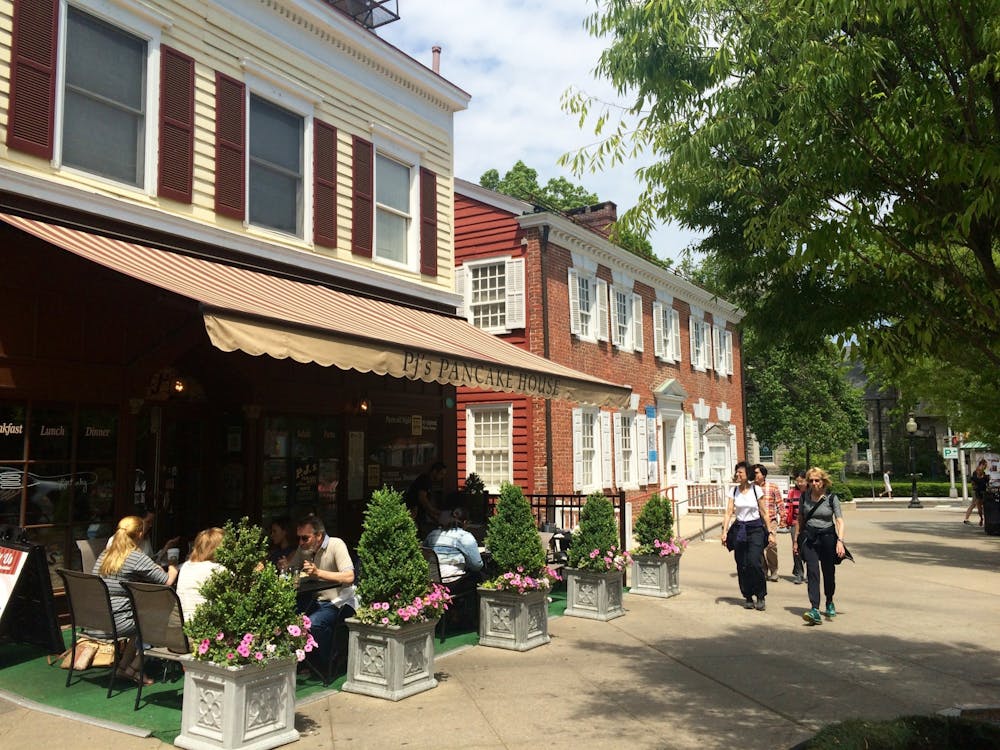"If you've ever rolled or fallen or ran or turned with joy, then you have danced, and Dance 209 is for you," says Ze'eva Cohen, laughing. She is describing a slogan she developed for the introductory modern dance class at Princeton, commonly referred to as "dance for klutzes."
Throughout her life, Professor Cohen has been a professional dancer, choreographer and performer, but to the Princeton University community, she is the heart and soul of the dance program.
When Princeton was still an all-male college in 1969, Cohen founded the dance program and has been the coordinator ever since. Under her watchful eye and unwavering vision, the program has taken its shape and direction.
Thirty-three years later, sitting outside the dance program's home at 185 Nassau, Cohen can confidently say, "I know it's working." Having produced professional dancers, choreographers, dance professors, dance writers and generations of dance audiences out of beginners, Cohen's approach to dance does indeed seem to be working.
The program attracts students from all majors, cultural backgrounds and levels of experience. For Cohen, it is the program's ability to find common denominators amongst the students that has made it successful. Divided into 3 levels — introductory, intermediate and advanced — the program has accommodated professionals and beginners alike.
Restricted by the format of a liberal arts education, the Princeton dance program cannot compete with professional training schools or conservatories. However, this does not bother Cohen, who says, "Our goal is not to produce dancers. If they want to become dancers, they can."
Instead, Cohen believes in a holistic approach to dance that encourages the development of concepts rather than skills. She does not polarize academics and performers. Rather, she seeks to integrate the two — to approach dance simultaneously through what she calls "experiential and reflective" angles.
The Princeton dance program is based in modern dance. "We went modern because it allows for creativity and encourages diversity," explains Cohen. The faculty is comprised of experts in modern dance, including performers and choreographers. All students in dance courses are exposed to both the technical and creative aspects of dance and are encouraged to choreograph pieces.
According to Cohen, it is experimenting with choreography that encourages students to find original voices, to think independently, to ask questions, and to challenge tradition.
"I do not teach my modern dance classes in one style," says Cohen. "Instead, I encourage an approach that looks for commonalties in all styles."
In addition to the technique classes, the dance program also offers topical courses that are intended to develop a historical and aesthetic appreciation of dance. Through writing, reading, guest lecturers and videos, Cohen hopes to expose her students to all the many facets of dance, especially in a multicultural context. Says Cohen, "The program reflects a need to inform students of a rich global dance culture."
Looking for ways to open the door to diverse dance cultures, the dance program is offering three curricular courses this semester which look at dance in a cultural context — "The American Dance Experience and Africanist Dance Practices," "Baroque Music and Dance through Study and Performance," and Cohen's own seminar, "Body and Spirit: A Compar-ative Approach to Sacred Dance." According to Cohen, her seminar is an examination of how cultures and traditions allowed or disallowed the body to be part of the spirit.

"My course is different from other classes at Princeton," she explains. "I'm trying to find a way to bring together the physical and intellectual. . . to find a middle ground."
She believes the only way to understand another culture is to take part in it. "And who else can do it but dancers!" exclaims Cohen, who dedicates a full third of her course to the physical experience of dance forms. "I want them to transform knowledge in and out of the body."
In addition to offering her own experience, Cohen brings in specialists from various traditions in dance. "It is important," Cohen says, "for our students to be exposed to scholars and writers of dance. A narrow topic gives students a meeting place to learn from them."
Even after three decades, Ze'eva Cohen is not done with Princeton quite yet. "We stretched the envelope. I'd like to stretch it further," she says when looking back at her history at the University and contemplating her future here as well. "My goal for [this] decade is to bridge the intellectual and experiential." This is precisely what she has begun with the "Sacred Dance" seminar.
"Maybe that will be my legacy for Princeton," she adds with a smile.
After all these years, the most rewarding aspect of the dance program for its founder remains the students. "I'm so happy with this job and I've stayed so long because I've gotten such a charge from the intelligence, curiosity and appetite of the students," Cohen says happily.
And as for the "klutzes" that she still actively recruits, Cohen says, "I love beginners. At the end of the course, they think differently of themselves as movers and participators in this world, and as dance audience. Something changes."
She then pauses before adding, "I can only be as excellent of a teacher as I am because I have excellent students."







